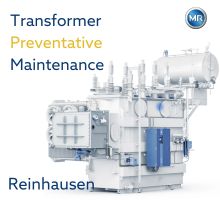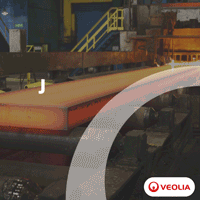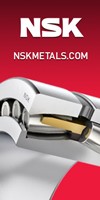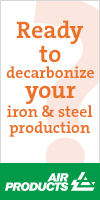SAIL Takes Measures to Preserve Sliding Q4 Profits
05/29/2009 - SAIL reports a 37% decrease in profit for the fourth quarter of fiscal year 2008-09 vs. the year-ago fourth quarter.
SAIL (Steel Authority of India Limited) recorded a profit of Rs. 1,486.68 crore after tax for the fourth quarter of financial year 2008-09, despite the current economic situation and recent rise in input costs.
The company’s profitability was 76% higher in the fourth quarter than the previous (third) quarter’s PAT, although it was also 37% lower vs. the year-ago fourth quarter. The company’s fourth quarter results compare t the year-ago fourth quarter and the recent third quarter as follows:
- Turnover, Rs. 13,008 crore, was 16.2% lower than the year-ago fourth quarter and 30.8% higher than the previous quarter (Q3 08/09).
- EBDITA at Rs. 2,658 crore was 34.1% lower than the year-ago fourth quarter and 57.8% higher than the previous quarter (Q3 08/09).
- PBT at Rs. 2,287 crore was 37.6% lower than the year-ago fourth quarter but 81.9% higher than the previous quarter (Q3 08/09).
SAIL said it had implemented several internal measures that allowed it to achieve strong performance despite the severe slowdown faced by the global steel industry in the second half of FY ’09. These measures helped the company to achieve high cost efficiency, higher production of value-added items, best-ever techno-economic parameters and continual improvement in productivity. Improved domestic market conditions allowed domestic sales to bounce back during the fourth quarter, to a level 50% higher than in the previous quarter (Q3 FY ’09), which led to a significant reduction in stocks. The company also brought down its overall inventory of semis and finished steel and raw materials by about Rs. 2,800 crore during the quarter.
Continuing its effort to expand the production of value-added products, SAIL achieved its highest-ever quarterly production of high quality rails at 263,000 tonnes in the fourth quarter—9% higher than in the year-ago fourth quarter. SAIL’s production of higher-grade TMT bars was up by 40% in the fourth quarter, while tinplate production was up by 72% and galvanized products were up by 7%.
The company achieved its best-ever techno-economic parameters during the fourth quarter, including the lowest-ever coke rate of 509 kg/tonne of hot metal – a 3% improvement over the year-ago quarter, while the company’s highest-ever blast furnace productivity at 1.58 tonnes/cubic meter/day was 4% better than in the year-ago quarter. In a major cost-saving effort, SAIL reduced its percentage of costlier imported coking coal in the blend by 5%, replacing it with cheaper indigenous coking coal. The company said that all these measures could result in savings to the tune of over Rs. 750 crore during the fourth quarter alone.
With the fourth quarter pick up, SAIL said it could achieve record turnover of Rs. 48,681 crore (equivalent to over $10 billion) in FY ’09 – 6.9% higher year-on-year. During the year, SAIL recorded before-tax profit of Rs. 9,403.45 crore and after-tax profit of Rs. 6,174.81 crore – both 18% lower year-on-year. The impact of higher input costs during the year amounted to over Rs. 7,000 crore, of which more than Rs. 6,000 crore was on account of coking coal.
During financial year 2008-09, SAIL produced 12.5 million tonnes of saleable steel by achieving 113% capacity utilization. The company produced 14.4 million tonnes of hot metal and 13.4 million tonnes of crude steel, matching the previous year’s levels. SAIL produced 66% of its crude steel tonnage through the energy-efficient continuous casting route, a record-high percentage for the company.
The company improved its product-mix significantly through the year, with 11% growth over the previous year. Its share of value-added steel (within overall production) grew to 30% during the year as compared to 27% in 2007-08. The company also achieved best-ever techno-economic parameters during 2008-09, with improvements recorded in all major indices – coke rate at 521 kg/tonne hot metal (+2%) and specific energy consumption at 6.74 Gcal/tcs (+3%).
The company improved its product-mix significantly through the year, with 11% growth over the previous year. Its share of value-added steel (within overall production) grew to 30% during the year as compared to 27% in 2007-08. The company also achieved best-ever techno-economic parameters during 2008-09, with improvements recorded in all major indices – coke rate at 521 kg/tonne hot metal (+2%) and specific energy consumption at 6.74 Gcal/tcs (+3%).
With best-ever sales of 4.45 million tonnes of long products, SAIL achieved total sales of 11.32 million tonnes during FY ’09. Supplies to projects of national importance reached a new high during the year with sales to the power sector growing by 44%, sales to the telecom sector growing 58%, and sales to Railways growing by 4%. The company further expanded its distribution network, and its sales of reinforcement steel for construction through the dealer network reached 520,000 tonnes, a 50% increase over the year-ago fourth quarter. With a view to provide value-added steel for general construction, SAIL also commercialized its production of higher-grade earthquake-resistant steel during the year, with 90% of total TMT bar production now in this quality.
The company also continued to focus on rationalizing manpower during the year, achieving an overall reduction of over 7500 employees during 2008-09 after accounting for around 1300 fresh additions to improve skill and age-mix. This brought down SAIL’s manpower further to 121,295 as of 31 March 2009. The company said it would continue to focus on manpower rationalization through the current year as well. The company has made full provision to the tune of over Rs. 5,000 crore related to the wage revisions, which are due with effect from 1/1/07, in its financial accounts for the year 2007-08 and ’08-09.
The company’s capital expenditures reached Rs. 5,233 crore during 2008-09– 2.5 times higher than in the previous year, while capex for the current year is expected to reach Rs. 10,000 crore. To meet the ongoing modernization and expansion schemes, SAIL raised Rs. 735 crore from the market through long-term bonds during 2008-09.
SAIL’s debt-equity ratio as of March 31 was 0.27:1, which compares to 0.13:1 as of March 31, 2008. Major units commissioned during the year include a 250-MW power plant in joint venture with NTPC at Bhilai; a second 250-MW unit is likely to go on-stream in the current financial year. Construction of 2.2-million-tonne slag-based JV cement plant is in full progress, and the plant is likely to be commissioned within a year. During the past year, SAIL also commissioned a slab caster and secondary steelmaking facilities at Bhilai; an oxygen plant and cold dust injection in two blast furnaces at Durgapur; a pipe coating plant at Rourkela; and an upgraded Hot Strip Mill and oxygen plant at Bokaro.
SAIL’s debt-equity ratio as of March 31 was 0.27:1, which compares to 0.13:1 as of March 31, 2008. Major units commissioned during the year include a 250-MW power plant in joint venture with NTPC at Bhilai; a second 250-MW unit is likely to go on-stream in the current financial year. Construction of 2.2-million-tonne slag-based JV cement plant is in full progress, and the plant is likely to be commissioned within a year. During the past year, SAIL also commissioned a slab caster and secondary steelmaking facilities at Bhilai; an oxygen plant and cold dust injection in two blast furnaces at Durgapur; a pipe coating plant at Rourkela; and an upgraded Hot Strip Mill and oxygen plant at Bokaro.
The above performance has been achieved in the backdrop of the company holding its price line for three months in H-1 of FY ’09, when market conditions were buoyant, and coping with unprecedented rise in input costs, higher manpower costs and the adverse impact of global meltdown in H-2.
"SAIL has proved its resilience in facing the challenges thrown up due to unprecedented developments in the steel industry and overall business environment,” said SAIL Chairman S.K. Roongta, commenting on the company’s performance. “The revival in steel demand began in Q4 and trends in the current quarter are also encouraging. With major boost to infrastructure building in the offing, we expect steel demand in the country to grow further in the current financial year.”



-(220-x-200-px)-(130-x-130-px)-(220-x-200-px).jpg?lang=en-US&ext=.jpg)
Veolia.gif?width=200&height=200&mediaprotectionhash=4deca34a0d5a00013b5a0ccdc2dcf98fd2c17aabb57eb7bbb27200552f29c247&ext=.gif)





